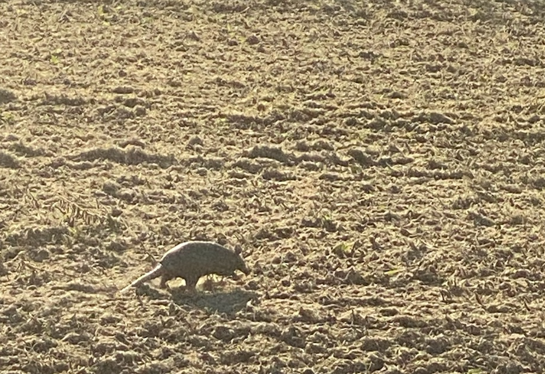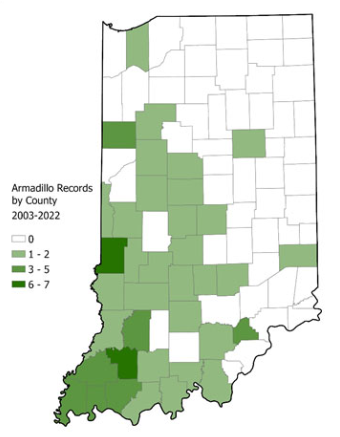(Rockport, IN) - Dustin Epperson still feels an adrenaline rush whenever he spots a bobcat running from the corn he’s harvesting.
Yet, he was more baffled upon first seeing an armadillo in the soybeans he was cutting in southern Indiana.
Epperson, 25, is employed full-time at Vogel Seed Farm, which has about 4,000 acres of corn and soybeans outside Rockport, about 40 miles east of Evansville near the Ohio River.
“It was pretty crazy,” he said.
On October 2nd, Epperson said he was cutting in the middle of a soybean field, and out from the dust stirred by the combine in the sandy ground came an armadillo, a species usually found in states like Texas and other areas of the south and southwest. He was able to get the combine close enough to snap pictures and video of the armadillo before it “jumped up and took off running.”
Epperson’s brief surge of virality occured shortly after he posted the images on social media.
“The next thing I know it was all over Facebook,” he said.
Epperson said he was also contacted by a reporter from WFIE TV out of Evansville about his discovery.
He’s known for years that bobcats populate the area and sees them, occasionally, darting out from the corn being harvested. However, the only armadillo he'd seen before was on television. Epperson knew it was an armadillo, though, because of its shell.
“It was pretty big, I guess. It was bigger than a possum,” he said.
According to the Indiana Department of Natural Resources, the nine-banded armadillo, growing to about the size of a cat, is the only armadillo species in the U.S.
In Spanish, armadillo translates to “little armored one,” referring to the bony, armor-like leathery skin covering most of their body that gives the species a unique, easy-to-identify appearance.
Originally, the nine-banded armadillo was native to South America and first documented in Texas in the mid-1800s as the species migrated north.
Designated the state small mammal in Texas, the species is also found in larger numbers in states like Oklahoma, Kansas, and Florida.
The first official spotting of an armadillo in Indiana was in 2003, with more than 70 other confirmed sightings mostly in the southern part of the state ever since. A decent number of those sightings have also been in the central and western parts of the state, and as far north as Porter County near Lake Michigan.
According to the DNR, the rate of armadillos marching into Indiana has increased with 80 percent of the sightings being from 2017 to 2021. Experts cite factors like warmer winters in the Midwest due to climate change to explain why armadillos are inching their way further north.
There’s more food now for the primarily insect-eating mammals to consume and the ground is less frozen, allowing the strong-muscled creatures to be active year-round, with their sharp claws on all four feet burrowing into the soil. Armadillos also eat things like roots, bird eggs, and earthworms.
Further migration of the species to the north is prohibited, because they’re susceptible to starvation along with hypothermia from having little fur and body fat to capture for warmth during extended cold periods, even while burrowed into the ground.
Per the DNR, armadillos also have a generally low body temperature.
Armadillos in Indiana are a protected species, with laws prohibiting them from being trapped or killed unless they are causing substantial property damage.
Epperson said he was still amazed at spotting an armadillo two weeks later.
“It was like looking at a unicorn. It took a minute for it to set in what it really was. I never would have imagined we’d have them this far north as cold as it gets,” he said.







